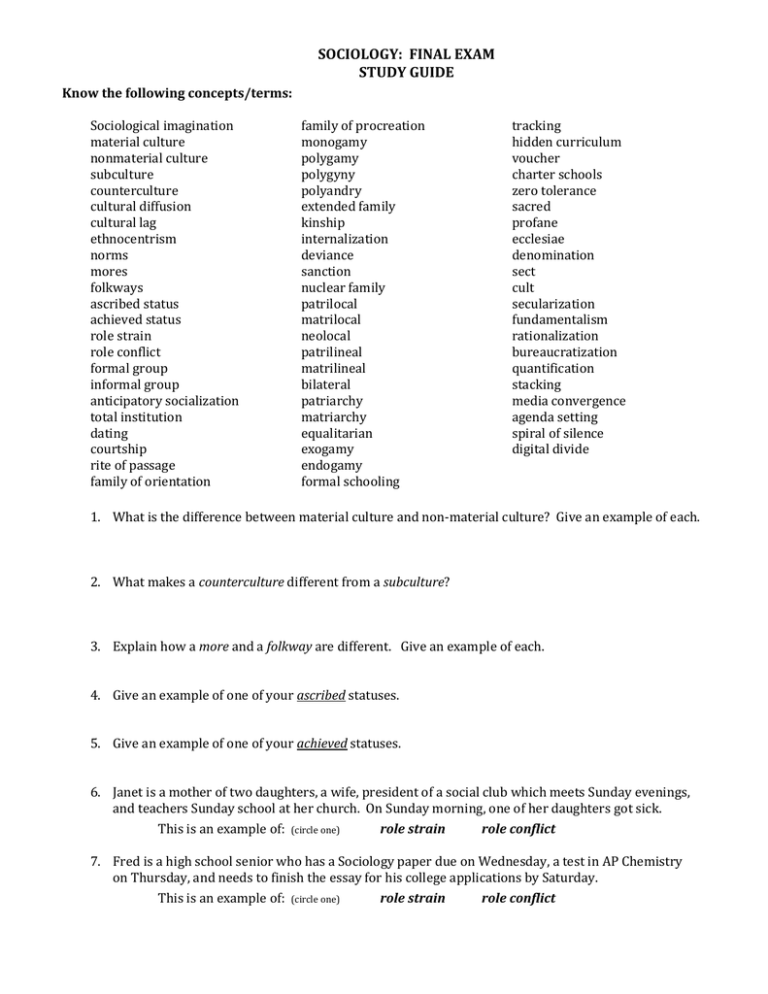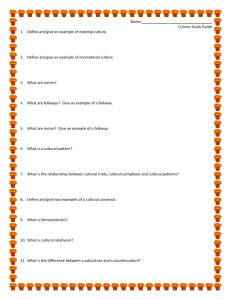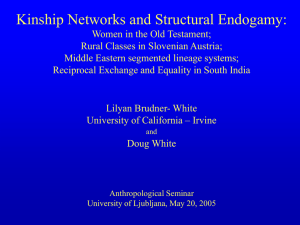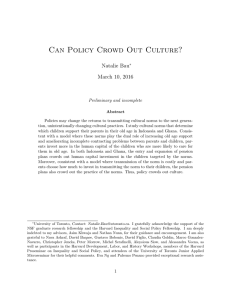SOCIOLOGY: FINAL EXAM STUDY GUIDE Know the following
advertisement

SOCIOLOGY: FINAL EXAM STUDY GUIDE Know the following concepts/terms: Sociological imagination material culture nonmaterial culture subculture counterculture cultural diffusion cultural lag ethnocentrism norms mores folkways ascribed status achieved status role strain role conflict formal group informal group anticipatory socialization total institution dating courtship rite of passage family of orientation family of procreation monogamy polygamy polygyny polyandry extended family kinship internalization deviance sanction nuclear family patrilocal matrilocal neolocal patrilineal matrilineal bilateral patriarchy matriarchy equalitarian exogamy endogamy formal schooling tracking hidden curriculum voucher charter schools zero tolerance sacred profane ecclesiae denomination sect cult secularization fundamentalism rationalization bureaucratization quantification stacking media convergence agenda setting spiral of silence digital divide 1. What is the difference between material culture and non-material culture? Give an example of each. 2. What makes a counterculture different from a subculture? 3. Explain how a more and a folkway are different. Give an example of each. 4. Give an example of one of your ascribed statuses. 5. Give an example of one of your achieved statuses. 6. Janet is a mother of two daughters, a wife, president of a social club which meets Sunday evenings, and teachers Sunday school at her church. On Sunday morning, one of her daughters got sick. This is an example of: (circle one) role strain role conflict 7. Fred is a high school senior who has a Sociology paper due on Wednesday, a test in AP Chemistry on Thursday, and needs to finish the essay for his college applications by Saturday. This is an example of: (circle one) role strain role conflict 8. Give an example of anticipatory socialization from your life. 9. Compare and contrast dating and courting. 10. Describe hunter-gatherer societies. 11. Describe agrarian/agricultural societies. 12. Describe industrial societies. 13. Describe post-industrial societies. 14. Give an example of a rite of passage. 15. Explain the changes that have occurred in the concept of adolescence since industrialization. 16. Give an example each: -formal positive sanction -informal positive sanction -formal negative sanction -informal negative sanction 17. List the people that make up the following family structures in your life: -nuclear family -family of orientation -family of procreation 18. What are the two types of polygamy? 19. When Robert and Patty (both middle-class) married, they lived with Patty’s parents until the finished graduate school. This is an example of this type of marriage: (circle one) endogamy exomogy And this residential pattern: patrilocal matrilocal neolocal 20. Prince Charles and Princess Dianna’s sons, William and Harry inherited their titles because their father is the son of Queen Elizabeth II. This is an example of this descent pattern: (circle one) patrilineal matrilineal bilateral William (royal) and Kate (commoner) is an example of this type of marriage: endogamy exomogy 21. Many Native American tribes are comprised of families where most of the authority is held by the mothers. This is an example of this authority pattern: (circle one) patriarchy matriarchy egalitarian 22. Give an example of both informal schooling and formal schooling. 23. Functionalist perspective on hidden curriculum in education: Conflict perspective on hidden curriculum in education: 24. Functionalist perspective on differentiation in education: Conflict perspective on tracking in education: 25. The 3 sociological functions of religion. 26. The 6 characteristics of sports as a social institution. 27. What is Title IX? Who does it protect? 28. Give an example of stacking in sports. 29. _______ Blogs, online newspapers, streaming radio stations 30. _______ Media’s control over what information is presented by limiting the opinions presented 31. _______ Lack of access to information in poorer segments of society resulting from limited exposure to technology 32. _______ The media’s use of its power to tell the public what to think, not to simply inform A. spiral of silence B. agenda setting C. media convergence D. digital divide





